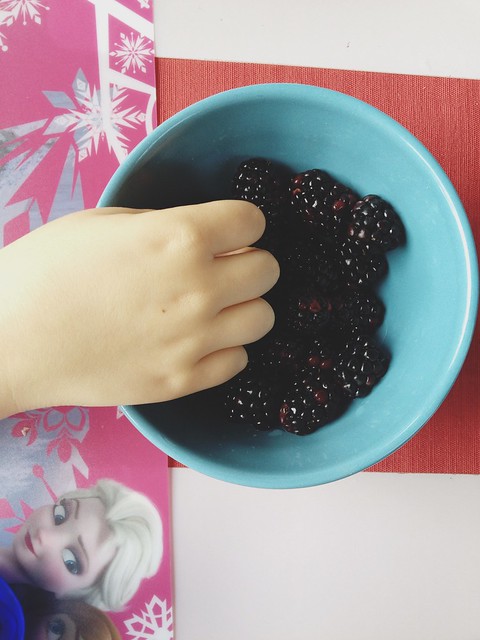Hello! I’m Alyssa. Rebecca’s (new) sister-in-law and she asked me to write a post on nutrition. I work in public health nutrition and am a registered dietitian. So let me start by saying that if you have specific questions about your child’s health or diet, I recommend asking your pediatrician for a referral to a registered dietitian that can do a thorough assessment and help create a tailored plan. However, there are some simple healthy changes that I find can be very helpful for kids AND their parents to establish healthy eating habits.
1. Eat Fruits and Vegetables! Make fruits and vegetables the go-to snack. Apple or pear slices, clementines, bananas, berries, sliced bell peppers and cucumbers... the list goes on. Anyone who’s been inside a grocery store knows that the aisle labeled “Snacks” is not filled with fresh produce. We are a snacking culture and American children get about a quarter of their total calories from snacks. Of course, including fruits and vegetables during meals is important too, but snack time is an often overlooked opportunity when kids may be at their hungriest (and more likely to eat foods they might refuse otherwise). Snacking on fruits and vegetables will make sure they get the vitamins, minerals, and fiber they need to stay healthy.
• Tips: If you shop at a farmer’s market or store that stocks local produce, go for things that are in-season as they will taste better and likely be cheaper. Kids are more likely to eat cut up fruits and vegetables, so that extra effort could make a big difference. If they’re still hungry, consider adding something with protein – like hummus, string cheese, low-sugar yogurt or nuts.
2. Drink Water! Make water the #1 drink. Sugary beverages like sodas, “fruit” drinks (think CapriSun), sports drinks, and iced teas have zero nutritional value. If you can eliminate them from your children’s vocabularies save the rare occasion, you’ll have eliminated the leading source of added sugar in American’s diets. Awesome, that’s huge.
• Tips: Add sliced citrus (oranges, lemons, limes) or cucumber to a pitcher of water and keep it in the fridge. Call it “spa water” and make it feel like a special treat. Unsweetened seltzer water is also something to try if your kids aren’t stoked with plain water from the tap. I’d steer clear of artificially sweetened or diet beverages.
3. Kids in the kitchen! Involving your children in the cooking process is SO important and ChopChop Magazine is my favorite resource to help families do just that. The magazine is written in a “for kids, by kids” fashion, with healthy and delicious recipes like their “Zucchini Pancakes” recipe below. You can check out a sample issue here that includes a “Cooking Methods” tutorial for kids to prepare broccoli four ways. Children may need to try a new food 10 – 20 times before they decide they like it (or not), and offering vegetables prepared in different ways can increase the chances they will.
4. Establish manageable rules! If getting your child to eat is a constant battle, check out the Ellyn Satter Institute’s website on division of responsibility in child feeding. It provides guidelines to give children the control they need to learn their own hunger cues and parents the freedom to not turn into short-order cooks. Cliff notes version: Parents are responsible for what, when and where food is served, and the child is responsible for how much and whether they choose to eat. Working toward these defined roles with your children means everyone knows the rules of the game.
What works for your family? Do you find it helpful to bring your kids grocery shopping to get them excited about cooking or have you had too many meltdowns in the cereal aisle? How do you get your children to try new foods? Please share!
Zucchini Pancakes
(from ChopChop Magazine)
Ingredients:
3 cups shredded zucchini (about 2 medium-sized zucchini)
1 teaspoon salt
2 large eggs, lightly beaten
2⁄3 cups whole-wheat flour
3⁄4 cups crumbled feta cheese
4 scallions, greens and whites, chopped
1 tablespoon olive or vegetable oil
Instructions:
1. Put the shredded zucchini in the colander and sprinkle with the salt. Set the colander in the bowl.
2. Using your hand, press down on the zucchini so that as much liquid as possible drains out into the bowl. Stir the zucchini and repeat. Throw away the liquid.
3. Put the zucchini in the bowl and add the eggs, flour, cheese, and scallions. Mix well.
4. Put the skillet on the stove and turn the heat to medium. When the skillet is hot (flick some water on—it should dance and evaporate immediately), add the oil.
5. Using the tablespoon, scoop blobs of the zucchini mixture from the bowl and spread it into a round, flat nest on the skillet: it should make a circle that's about 2 inches wide and 1/4 inch thick. Repeat to fill the skillet.
6. Cook until the bottoms are deeply golden, about 5 minutes, then turn the pancakes over and cook 5 more minutes. Repeat with the remaining mixture. - See more, here.
AK









0 comments:
Post a Comment